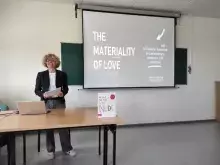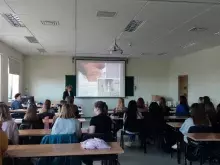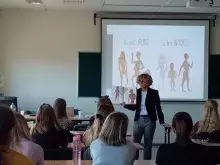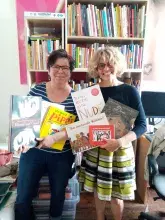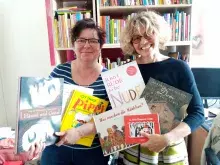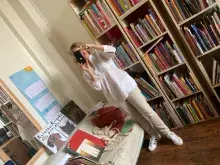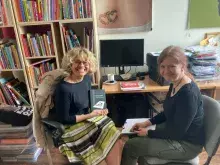Choosing a book for a child is a political act – interview with Marnie Campagnaro
Marnie Campagnaro, Ph.D., is an Assistant Professor of Children’s Literature at the Department of Philosophy, Sociology, Education and Applied Psychology FISPPA at the University of Padova. She was invited to the University of Gdansk by Małgorzata Cackowska, Associate Professor in the Institute of Education. Her visit was a part of the UG Visiting Professor Programme. Marnie Campagnaro spent a month in the Institute of Education of the Faculty of Social Sciences, sharing research passion to picturebooks with other teachers and students. During her stay she run a 20-hours students’ course concerning picturebooks and gave two open lectures, highly appreciated by all participants. Moreover, a new research cooperation was established (with prof. M. Cackowska) and we are looking forward to creating new research stories concerning children’s literature, it’s verbal and visual part.
Karolina Żuk-Wieczorkiewicz: Marnie, I’m pleased to be with you here and participate in your lectures.
Marnie Campagnaro: The great pleasure is also mine.
How is your visit going so far? What are your impressions?
It is a very enriching experience from many perspectives. First, it’s great to have an opportunity to teach in another University. When you’re in your own University, there is all that administrative and bureaucracy apparatus which steal time to teach and do the research, while being here, you’re totally focused on teaching and research, and this is a privilege. Second, I like the atmosphere in your University, but I think it’s a part of your culture to be so welcome and generous. The third element I really appreciate is having the opportunity to compare, to discuss, to reason about picturebooks teaching and research with a colleague, like professor Cackowska. It was an interesting aspect of my experience because when you teach, you are a bit lonely. Instead, having an opportunity of sharing ideas, aims, and goals about teaching with a colleague who teaches the same discipline – this is very “tasteful”. I also think it nourishes my way of thinking.
For instance, professor Cackowska’s studio is terrific because there’s plenty of books. Sometimes when you discuss a topic with students, you wish you could have books that represent this specific aspect. Professor Cackowska beautifully selected picturebooks: her collection contains a lot of awarded picturebooks from all around the world, from 0 to 100 years old. It is very interesting, because students can be offered materials to reflect and do comparisons. So I must confess it’s a really great experience to be here.
I’m happy to hear that. Why and when were you fascinated with children’s literature and picturebooks?
I would like to answer considering two levels. From the scientific and academic point of view, picturebook research was the core of my PhD study. My PhD research was about verbal-visual strategies in picturebooks. I paid a lot of attention to graphical and typographical aspects of a picturebook, its materiality, for instance the thickness of paper, the shape of the cover and typographical solutions, i.e. holes, flaps. Another aspect of my research project was linked to the illustrative style used in picturebooks. We – parents, teachers – usually consider that picturebooks for children should contain bright (and full) colours, but this is not true. Picturebooks can be also constructed using two colours or even one colour, only black, if the page is white. So this is the first level of my fascination with picturebooks: the academic one. The second level probably refers to my childhood memory. As a young reader, I started reading looking at pictures in books. For me, words are very important, but so are pictures: they can open your own imaginative spaces. They’re like windows. Words force you to stay stuck on the text – of course they can bring you to other worlds but words are very precise, referential. Illustrations give the opportunity to add gaps in picturebooks. For prereaders, who cannot read yet, pictures are really powerful. I think that’s why picturebooks are so appealing to me.
Considering two aspects in books: verbal and visual, do you think that one of them is more important than another or maybe they are complementary?
I think that the relationship between text and images in picturebooks can take different forms. Images can only be decoration and they are not meaningful for the story. Pictures can be referential, so that they tell the same story that is told by words, but they can also be enriching: they becomes complementary and they can really expand the story. They can also be counterpointing in a way that the words tell one story and pictures are showing a story which is completely different, i.e. hilarious or ironic. I don’t think any of these ways is better than another – it’s the author’s and illustrator’s part to choose the best relation in order to make the story as fascinating as possible.
During the last lecture you said that choosing a book for a child is a political act. What criteria should be taken into account when we choose a book for a child?
It’s a very good question and a very difficult question at the same time. First of all, I think that when adults (teachers, parents) choose a book, they should be very honest with themselves. We should be aware that when we choose a book, we have an idea of a childhood in our mind. So probably the first thing we should do as adults is answering the questions: „What is my idea of childhood? What kind of child do I have in mind and why is it that? Considering the children’s publishing market – am I looking for books with a child protagonist that is willing to accomplish rules, habits, customs of the societies or am I looking for a child that is able to challenge rules, habits and customs of adults?”. Nevertheless, if we choose this second option, we need to be prepared to be criticised. This is the first aspect that should be taken into consideration.
The second aspect is the beauty of a book - and when I say “beauty”, I am not referring only to aesthetic aspects. Beauty arises from different elements, and it is not linked to perfection. There are beautiful stories which are a tribute to imperfection. I think that this is the challenge: to find beauty in imperfection. We as human beings are imperfect – so offering this kind of books, with imperfect characters, and there’s beauty there, it’s like saying that although we are imperfect, there’s beauty in us.
Another important issue when we choose a book for a child is to choose a book that helps him to enlarge his imagination. We should offer children divergent images and illustrative styles. I think this is very important because a child is able to remember, to reuse what he actually remembers and to transform it and use his imagination according to what he was able to experience. I don’t think that fantasy and imagination is something which is already inside us. There are three levels of getting experience. The first level is storytelling, the second - one’s own experience. These two levels are very important, very personal, but I also think that these first two aspects are limiting as they are linked to reality. Having the possibility of entering other worlds, worlds that don’t even exist, this only belongs to literature and poetry. When building a book list, it’s really important to be aware that although the stories about everyday life are fine, these stories are settled in familiar contexts, very common. Contrarily, entering other worlds is something that only literature can assure. I think it’s very precious for children - not only from literary or cultural point of view, but also from educational point of view: if you offer other worlds to young readers, you are telling them that a new world is possible. Going back to your question about “choosing a book as a political act” – I think that when you choose a book, you tell young readers that there are also other ways to do things. And if there are other ways to do things, it means that there are also the possibility to conceive different worlds. And for me, what really matters in a children’s book is not “happiness” but “hope”. An American writer, Katherine Paterson, affirmed that hope is more than happiness.
You mean it gives the chance to change something which is not necessarily good?
Yes. “Happiness” is stable, it’s very rigid. It describes a sort of a perfect world, you can’t change it. But what about a story where there is conflict which is moving? Well, if there is no movement, there is no story, I think. When there is a conflict in movement, the story may go in a good or not such a good way – but beyond it, there is hope that things can go different and that one can solve the problem. This is the most powerful message. We have come through dreadful experiences during the last few years because of the pandemic, and now because of the war. Can you imagine talking to a child about happiness in todays’ context?
It seems inaccurate.
It’s too far away, it’s utopia – fine, it is good, but instead, it’s hope that gives the energy to make new steps.
To make change?
Yes. That’s why when we choose a book, we should be aware of that. What is the most important thing for you? Would you rather choose the story with a happy ending, which is good, of course, but what about choosing a story where a child has to take an adventure which is very dangerous, where many bad things happen, but still he/she is resilient and keeps looking for a good ending. This is hope.
What do you consider the main challenge for book designers, authors and illustrators nowadays?
I think the main challenge is to find a good story. This is difficult. Looking at the Italian publishing houses and children’s literature, good authors are lacking right now. There are really good illustrators who can do marvellous things but what is really missing are powerful stories, stories which are able to resist the passing of time.
Universal stories?
Yes. I think that there’s no great difference between stories for adults and stories for children, it’s just a matter of language. But the content of the stories – it’s just the same. I think that both adults and children look for the same things which are: love, friendship, identity, death and how to face them (at different levels of course). I also think that the story should basically answer to three basic questions: 1) “Who am I?”; 2) “Where do I come from?” and 3) “Where am I going?”. A good story should talk about these aspects. For example, the question “Who am I?” is not only a question for adults, but also for a child: “What kind of child am I?”. There was book published by Bruno Bettelheim a long time ago (in 1976), The Uses of Enchantment, where it is said: “The monster that the child is most afraid of is the monster that he fears to have inside him”. So the question “Who am I?” is very pertinent. These questions happen in different moments of a child’s life, when a new brother or sister arrives in a family – and you don’t want him or her, because you want your mum and daddy to be only for you. Parents tell a child that it is not good crying, but then if the baby is crying, they cradle him/her. Why is there such a difference between the child and the baby? This is injustice for a child!
As I said: it is a very compelling question. What I consider nowadays the most big challenge in children’s literature is to find a good story. Writing a good story is like making a cake. The basic ingredients of a cake are eggs, flour, milk, sugar and a bit of salt maybe. They are always the same. What makes the difference is how you are going to put them together and in which order, the temperature of the oven, and so on. I think that an extraordinary alchemy to “cook” a good story.
According to your research, when you compare earlier books and contemporary books – how have they changed?
Now children can choose among a great richness of books: fiction, non-fiction, wordless picturebooks, book-objects. But I think that – referring to Italian landscape, of course – it’s not such a good moment for children’s literature. Apparently, it seems that these stories are more innovative than the past ones, but I’m not quite sure about that. I think about some books that were published in the 60s and the 70s: they were much more challenging, much more audacious. Nowadays, there is a tendency of transforming stories into didactic tools. Let’s talk about gender equity or inclusion, for instance: they seem very innovative topics, but they are unfortunately included into stories in such a didactic way, so predictable. There is little literature there I would say. In my opinion literature is always politically incorrect. And I don’t think there is a lot of political incorrectness right now. Many authors (at least referring to the Italian book market) are looking for things and facts that they know people will like.
It seems a marketing approach.
Yes. Publishing houses don’t really dare to publish “politically incorrect” stories because books need to be sold, first of all. Books are a commercial product. Publishers can’t afford making books that only a few will buy. On the other hand, there are stories people really need. It’s a difficult matter. A really great Italian author and traslator, who is also the editorial director of an important publishing house, told me that right now marketing officers are even more important than editorial directors. This is the point. It is sad but true – for adult’s as well as for children’s literature. There is a sort of rush (especially in bigger companies) to public lots of new books but Novelty is not always synonymous of quality. That’s why I think that classics should be still offered to young readers. This morning, during the lecture, when I asked “Do you have a book which is important to you?” two students mentioned two books: Anne of the Green Gables and Pippi Langstrumpf. Pippi, for instance, was published in 1945 and it was and isa a challenging masterpiece, still much loved. Can you imagine being a child in 1945, during the second world war, and being a child nowadays? They experienced two completely different political, cultural and social context. So, how is it possible that children living now and then both loved this book? It means that there’s something special inside the book, and in fact – it’s a good story.
As you said: the story should be good regardless the passing time or conditions around.
Exactly. Good stories speak about authentic human problems. There’s something in Pippi that will continue speaking to children for a long time to come. Pippi is so different, so authentic in what she says, in what she does, in what she thinks. Additionally, she’s really politically incorrect. Why? Because she tells the truth. It’s amazing: she’s a revolutionary character because she tells the truth – no matter where she is, no matter who is in front of her.
It seems we need such “politically incorrect” challengers who tell the truth.
Yes, definitely. The question is: is our society is willing to offer young readers “politically incorrect” challengers?
It seems a challenge we should face. I hope that there will be a lot of good stories created, then. Thank you very much.
Thank you. It was a really nice time.





